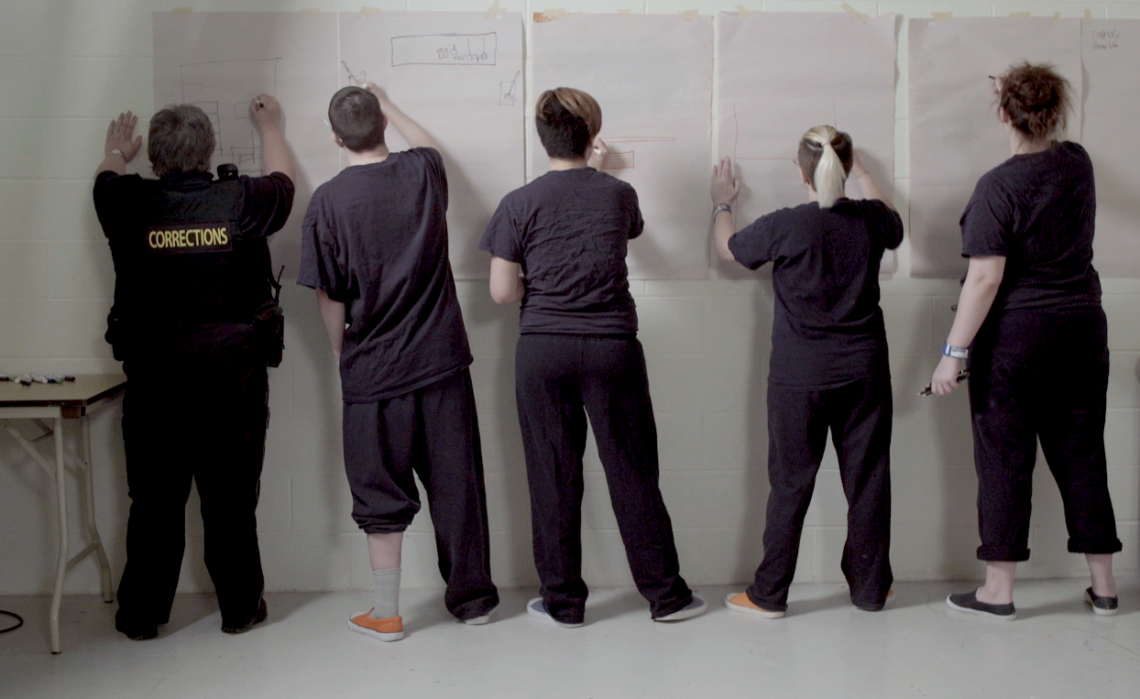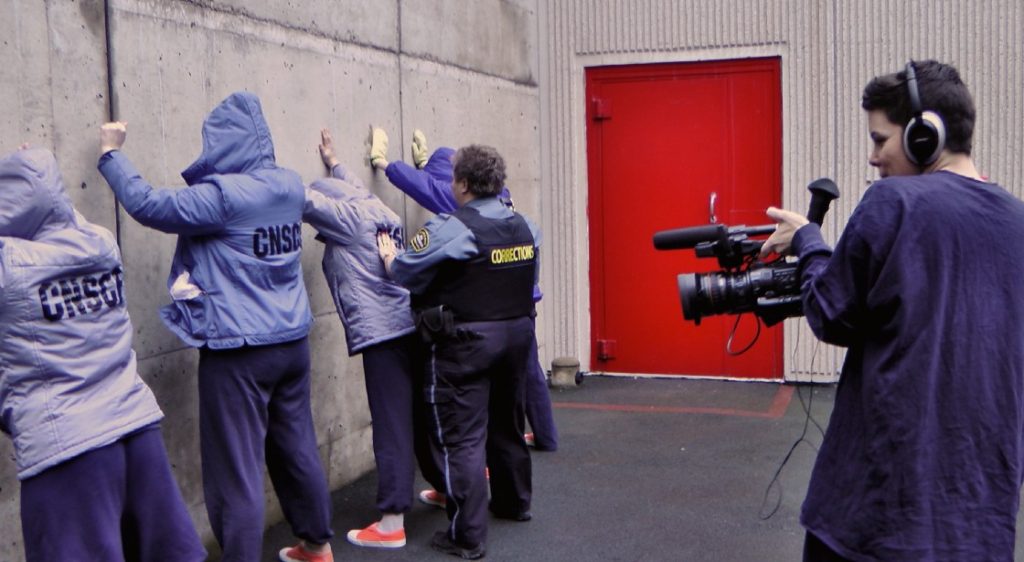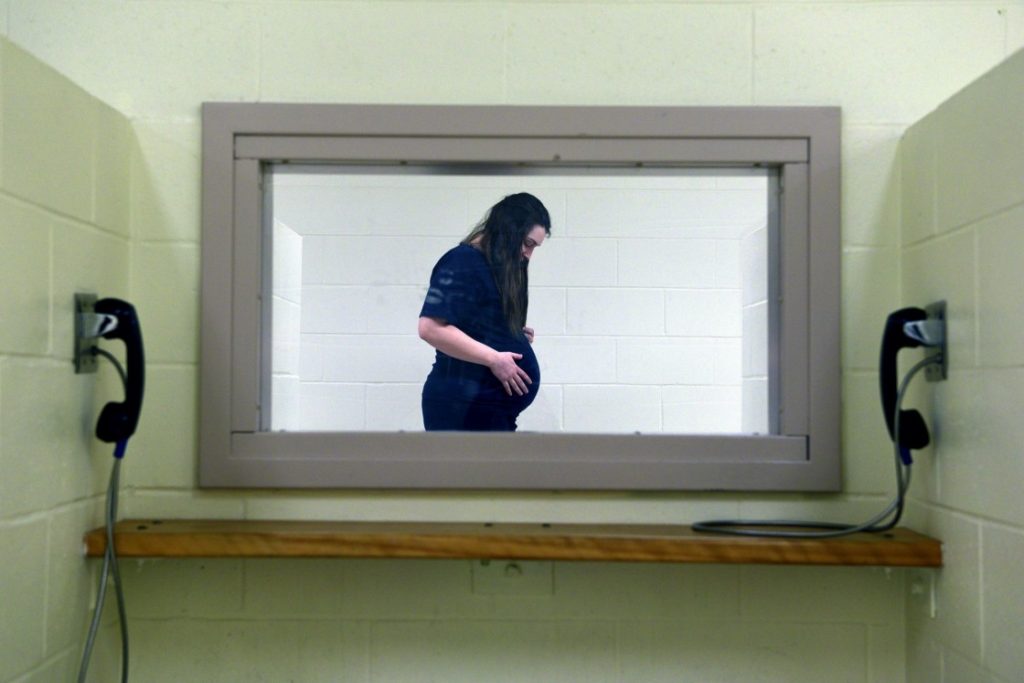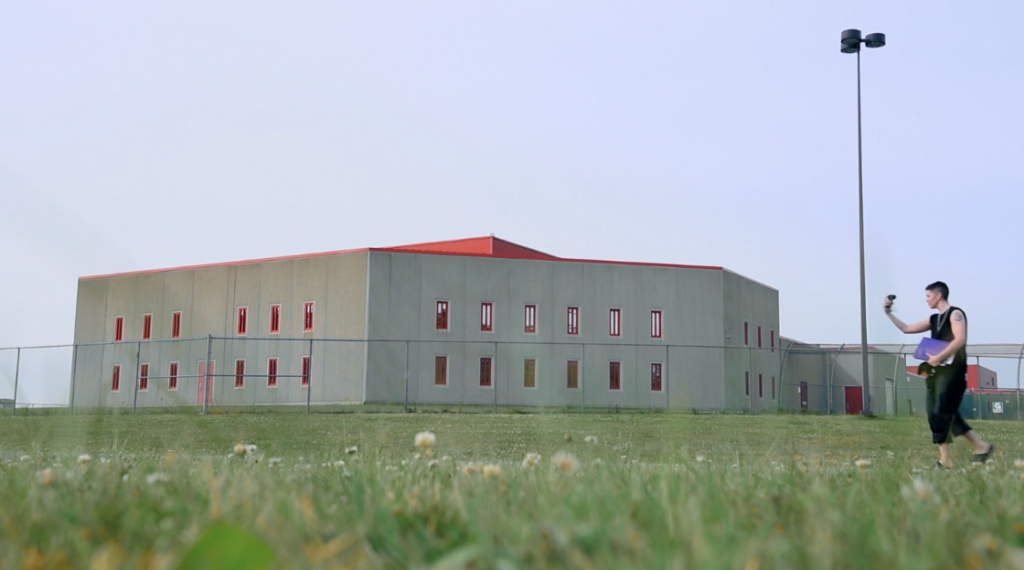
Conviction Interview: Ariella Pahlke and Teresa MacInnes
“We wanted to turn around [the conventional documentary format] and have them offer their solutions and their ideas. To be in control of what they wanted to share and how they wanted to share it. We felt strongly about giving the women a voice in whatever way they wanted to have a voice.”
It started with a statistic, women are the fastest-growing prison population, and ended with a plea for change.
CONVICTION explores the prison system through the eyes of the women inside the Central Nova Scotia Correctional Facility. It is heartbreaking to see the hope and excitement on the faces of these women as they step through the front gates to a new life. Only to watch as they fall back into the patterns that keep them inside the prisons high walls.
The beauty of this documentary is the women who take the cameras into their own hands, using their creativity to document their struggles outside the routine of prison. You watch their ups and their downs — nothing is too personal.
It is through their lived experiences and hope for change that a dream is created, From The Ground Up, a society that will help to rehabilitate women after prison.
CONVICTION gives an authentic perspective on the prison system and allows a marginalized group to find their voice. The documentary was directed by Nance Ackerman, Ariella Pahlke and Teresa MacInnes and features Caitlin Hill,
Bianca Mercer, Treena Smith, Laura Toney, Tanya Bignell, and Kim Pate.
You can see CONVICTION at this year’s Hot Docs Film Festival, screening as part of Canadian Spectrum. The World Premiere is on April 28th at 6:30PM, April 29th at 1:15PM and May 2nd at 12:30PM.
Tell us a little bit about yourself and how you got involved with filmmaking.
Ariella Pahlke: I got involved with filmmaking because I studied philosophy. I was interested in exploring some of the similar issues and questions that I was exploring in philosophy but in a more public and more creative way. Somehow I got involved with radio documentaries and then I was also doing community activist videos that were collaborations with groups and that sort of merged into just focusing on documentaries.
Teresa MacInnes: I have a sort of similar story but different. I was going to become a psychologist and I ended up doing a short video on my honours thesis with a group of people who were on methadone maintenance. At the time I was working with Bruce Alexander at Simon Frasier University and our government was trying to eliminate it and my honours thesis was all around it so I got to know a lot of the people. I was helping them with the letter-writing campaign and one of them said to me ‘Why don’t we rent a camera and tell our story and show the government how much this has helped our lives.’ I just naively said ‘Oh yeah that sounds like a great idea.’ So I ended up making this video and it involved the person whose idea it was, he did the interviews, and we went out and met all these people and made this video and it was such an empowering process for the people who were in it.
I just never got over that experience and so I kept making films and ended up moving away and got my little honours degree in psychology and then moved away from that. Even though I kept going back and forth between social work, I kept going back to wanting to make films because I kept working with people that needed their bigger story told. They were trapped within the system, trying to make a change. So I come to it not seeking out filmmaking but more from the issues that need to be addressed.
Can you tell me about Conviction and how you all came together to create this film?
TM: It was an interesting process because all three of us had very separate careers. We just decided we wanted to work with each other and met for over a year about a bunch of issues. This particular issue was one that all three of us had connections to but in very different ways. One of the big connectors was that I had met Kim Pate on a film I had done several years ago and so had Nan [Nance Ackerman]. These issues need to be put out there and addressed. The issues being that women were the fastest-growing prison population and that many of the women in prison came from highly marginalized backgrounds. It wasn’t a coincidence, it was too many people, and so that seemed to be the project that really stuck, the one I had the most passion for.
AP: It was also the fact that we wanted to explore the statistic that we thought was a bit puzzling, that women were the fastest-growing prison population. We wanted to explore it from the perspective of women in prison. We wanted to offer them a way to collaborate with us creatively in the filmmaking process and through writing and music and art.
I had done a number of other collaborative projects. I was the artist in residence at the medical school at Dalhousie for a year. I did a whole project with the Nova Scotia Rehab Center that was made collaboratively. We worked with some patients and families and staff and this project really grew the approach we wanted to take for this project. We wanted to turn around [the conventional documentary format] and have them offer their solutions and their ideas. To be in control of what they wanted to share and how they wanted to share it. We felt strongly about giving the women a voice in whatever way they wanted to have a voice. They are marginalized and some of them said to us afterwards that nobody has actually ever asked them what they thought about anything.

You focus on just a few of the women, how did that collaboration come about?
TM: I think that whenever you make a film, especially if you start with a group there’s some that naturally want to participate more than others. The ones that are actually featured had a particular interest, they really had something they wanted to say. It’s really important also to talk about the way that we did consent for this film. It was an ongoing consent process. It was really important to us that they really understood what they were doing, that this was something that was going to be public and they had quite a long time to change their mind — everybody in the film actually. I think it was really a combination of those who gravitated towards the project and wanted to do more and also those that we felt could consent in a way that they seemed to have an understanding of what that entailed and were enthusiastic and really saw advocacy as part of the path, to educate people.
AP: There were also people who, as you can see in the film, we gave cameras when they left. The women that we ended up focusing on, who were participants and collaborators were, like Teresa said, self-selected in the beginning but as it continued it was the women who really kept in touch with us and wanted to connect. [They] called us up and said ‘I’ve got footage for you do you want to watch it, you want to see it together, what can we do about it.’ It was a two-way street, us trying to keep track of them, but also those who kept in touch with us.
Speaking about the women who did take the cameras once they were outside, there was some very personal, kind of shocking images that they ended up shooting. What was that like to get back and talk to them about putting in the film?
TM: Actually, unless they choose not to, we encouraged them to look at it and sign off on it. But your first question was what was it like to get back and we were incredibly touched by the pure commitment. For Caitlin, I know it was really important for her to bring awareness to the effects of borderline on people and she specifically wanted to keep diaries to give an idea of what it’s like. She was incredibly honest and giving and generous with that and it was just something she really wanted people to be aware of. I think we were touched more than anything by the commitment and their honesty and their bravery. I was and I think we continue to be in awe of them for that.
AP: With everything that they gave us there was lots of back and forth discussion about whether it should be included in the film and sometimes people change their minds. We were always very open to talk about the repercussions or what it would mean if what they were showing would get out into the world. What that could mean for them and their lives and why they felt that that would either be important to have in the film or maybe felt that they didn’t want it in the film.

How much footage did you end up getting and what was that like to edit?
TM: [laughs] It was hard, we had hundreds of hours. The editing went eight months in the cutting room and we all worked really hard at it. It was difficult but we were very fortunate to cut a feature. There are not very many opportunities to do that so we’re happy that we got the chance to do a longer cut than usual. There’s stuff that we left out but I think the best is in there. I don’t think that we’ve talked about that Ariella.
AP: I think we could have made a series easily. We had more ideas and as you can imagine peoples lives go on and there is more that we could say. I think it could go on and on, this documentary, and to me, I think it could be a lifelong project.
TM: Editing is just so subjective to what you leave in and what you take out. There was a lot of discussions which is probably why it took as long as it did. With three people and at times others who were weighing in, our broadcaster Joanna Ross and co-producer Annette Clarke also had input and we had really great assistant editors and a consulting editor. So there was a lot of people who weighed in on it, not just the three of us. Then, of course, there were the women themselves who had input. A lot of people, but I feel at the end it was made with love and a lot of thought and I think we did an awesome job considering our challenges.
Conviction is not just about the prison system but also discusses rehabilitation after these women are released. Can you talk about how this came about and what it was like to go through this process with them?
AP: We didn’t actually have a plan for how we were going to explore the topic, it came up because when we went to work with them in the correctional prison where we did most of the work, the Central Nova Scotia Correctional Facility just outside Halifax, we realized that the same women were leaving and coming back in. We would come and discuss this with them. It became a big discussion about what it is that’s missing on the outside and why you keep coming back.
The project became much more about society versus the prison. Out of that conversation, it was one of the guards, Tanya Bignell who was really involved with the film, she started asking ‘ well what would you need, what could exist if you could just imagine.’ Kim Pate also started with that question around money, ‘if you had a hundred thousand dollars a year, if you could imagine that for every one of you, then what else could exist instead of prison.’ And so this idea of alternatives kept coming around and then the women just started talking about this place that they wanted to design. People kept adding in ideas and that’s when we decided to ask them if they wanted to talk to a few architects about how they could help with that and that’s where the whole From The Ground Up project came, it was very organic, it came out of the discussion. It came out of the process, their thinking why they keep coming back to prison and what was missing for them on the outside.
How is the From The Ground Up project doing now?
TM: It’s still a dream, the women have a Facebook Group. They’re all continuing to work even though it’s slow and it’s a dream because they’re all doing things for themselves too. The architects are still involved, Tanyas still involved, the women are still involved. People who were featured in the film and were at the original collaboration there’s many of them involved. There’s a will and there’s a dream about it and it will be interesting to see what audiences take away from it.
We do want to tour the film, we are planning to do this in conjunction with various chapters of the Elizabeth Fry Society. Every community should have their own From The Ground Up because every community has different needs and the bottom line is its kind of a metaphor for what we should establish in every community. A place that values the people with lived experiences helping other people with lived experiences. The answers come from them, they’re the ones who know what they need and I think we can build one of these in every community. That’s what we’re hoping people will take away from it.
AP: What really moved me from what the women were talking about was how much meaning they got from something they felt was not just there to benefit them but where they would also be able to help and benefit others. It was really about that kind of generosity where a sense of real value comes from. When you can do something you know will have meaning for somebody else. I found that really interesting.
Can you talk about all the women that worked on the film?
AP: From the very beginning, the very first workshop we did, we set up a bunch of art supplies on the table including cameras and microphones, video cameras, etc and people just gravitated to whatever they wanted to use to express themselves. Some of the people really loved using the cameras.
It was interesting how and when we gave the cameras specifically to Bianca Mercer, Treena Smith, and Caitlin Hill when they left, they all used them in very different ways as you can see in the film. Caitlin chose to take a lot of stills and she all of a sudden discovered that she liked taking abstract photographs. I thought that was really amazing, a lot of them were quite beautiful.
Bianca often recorded her surroundings and what she going through and almost kind of interviewed herself and did stream of consciousness about what she was going through. Treena would set up shots and paint on the mirror and looks at herself and there’s a lot of self-reflection in the way that she was using the cameras.
They all had different ways of using the cameras and they would also use the cameras to interview each other and ask each other things. They kind of became involved throughout the film in editing as well when they could. They would come in and watch their sections and talk about what they wanted to include and also what really would be important in terms of having meaning for the outside world in their stories. They were a big part of the filmmaking.
We also filmed that event, a panel discussion, and they filmed for that. Treena was really interested in learning more about sound so I was working with her to train her to do the sound recording. We really tried to share our skills with the women so that it might be a way for them to get into community college if they wanted to do screen arts or anything else they wanted to do in terms of media. They were really working with us when they could.
TM: Laura Toney was actually in the facility but she wasn’t eligible. She was friends with Bianca and very much wanted to be involved. She never got out of prison while we were there, well she did get out but ended up not doing any filming on the outside, so she does her filming on the inside. Laura was the one at the window and the door looking for grass. From her perspective, she did much more of her work from the inside which we found kind of interesting. She was someone who really sought us out to be involved in the film and we were glad she did because I think she’s a very important voice.
I think the women love Tanya. She was assigned to our project by the superintendent and we were really happy that she was because she was amazing. I think she just has such a big heart and she was incredibly generous to us and to the project. What she did, which doesn’t come out in the film, one of the gems we lost, she interviewed the women a lot and she chatted with the women within the prison. She just really, which you can see in some of the conversations, tried to get from them what they needed and really believed and still believes that these women need more community then what they can get from prison. We were very lucky to have had her involved.

Tell us about why you are a feminist and why it’s important to your filmmaking.
TM: I am absolutely a feminist. I was raised in an interesting era because I was coming of age when my mother was becoming a feminist in the 70s. I kind of grew up in this era with one foot in each camp where the women were in the kitchen with my grandmother and her sisters yet my mother was saying ‘what are you going to be, you can be a doctor, you don’t have to be a nurse.’
It’s just part of who I am and I can’t separate it. Why it’s important in my filmmaking is that we still have a long way to go. I’ve witnessed in my three decades of making documentaries, one step forward two steps back, and every time we think we’ve got somewhere, some kind of backlash happens. I’m reminded, especially in this industry, that it is a man’s world and even though we have a lot of initiatives and a lot of great things happening in the various funding agencies, it doesn’t necessarily translate all the time. Like all -isms, sexism, racism, it can be very subtle. It can be very overt but more times than others its more subtle. So I think those stories need to continue to be told. I can’t separate it from my work just like I can’t separate it from my personality. It’s part of who I am and it’s part of the struggle.
AP: I would say I am absolutely a feminist too. I grew up totally different from Teresa, I grew up just with my mother and I always had support from my family and in school. It didn’t really occur to me that women might be treated differently until later and I think that a lot of my work came from realizing that often women have a very different perspective and often that perspective is not heard. I just gravitated towards working with women in social issues, community activist work. I was in a really small community and I did a bunch of work with women in the fishery because women were not said to be working in the fishery but I realized they do a lot of work in the fishery. Then I started a group with women here where we publish newsletters, did documentaries and started a going back to school program for adult literacy. I ended up studying feminist philosophy and I think it affected everything I’m doing, in not just the content, but also the process. I think that women often have a different way of approaching things and a different way of approaching the relationships we have with people.
TM: This film was interesting because it was an all-female crew, basically, covering a very important issue which is women who are living in poverty or who come from poverty and it deals with women who have been abused and all those issues that keep women down. That occurs because of inequality and I don’t know about you Arielle, but it was tough for all those reasons.
AP: Yeah and it is much easier to work in a hierarchical way where people have very set rules or conventions. I think we really broke through a lot of those things. I think we tried things differently, and that’s not to say no one else has ever worked in this way, but I think we were definitely not working in a way that conventional documentaries would be made. In terms of the collaboration, in terms of the relationships to the subject, in terms of having three directors and the relationship with each other, in terms of the way we approached the issue of consent. It was non-hierarchical in many ways.
Finally, recommend one #MUFFApproved** film for our blog readers!
AP: Agnes Varda — Faces Places
TM: Tiffany Hsiung — The Apology
Keep up to date with Conviction: Facebook | Twitter | Instagram | Website
Keep up to date with the National Film Board: Facebook | Twitter | Instagram
*This post was originally featured on The MUFF Society.*

